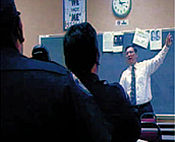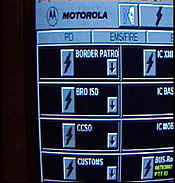The Trans Pecos area of Texas is
known for its harsh terrain, poisonous
snakes, drug dealers, and tough
cops. Shortly after the Trans Pecos
Drug Task Force applied for and received
its Mini-Buster Contraband
Detector kit from the Technology
Transfer Program, the kit's handheld
density detector led cops to almost a
quarter million dollars in cash hidden
in the rear bumper of a vehicle. The
fiberscope that comes in the same kit
made the marijuana in the gas tank of
the vehicle an equally easy find. In
Georgia, the Department of Public
Safety made a drug dealer there truly
unhappy when it used Mini-Buster
technology to find $1,000,000 in hidden
currency. Fifteen indictments followed.
Those cases reflect the broad
and speedy impact that advanced
technologies can have on local counterdrug
law enforcement.
Nightmare and Testbeds
Before the Technology Transfer Program
was proposed to Congress,
CTAC wanted to make sure local cops
would benefit from systems already in
the federal inventory, so a number of
towns, cities and counties were
selected as test beds. One of them is
Brownsville, Texas, at the border with
Mexico. One night, Brownsville cops
came under fire in an area where
police estimate that a thousand dollars
worth of marijuana walks into the
U.S. each night on the backs of young
Mexican men known as drug "mules."
Fortunately, the smugglers' security
men were poor marksmen. In the
exchange of gunfire that night, none
of the Brownsville officers was hit,
but at least one of the criminals was
killed. Still, it was a dramatic lesson
to Brownsville's Chief of Police, Ben
Reyna: "With the narcotraffickers
having demonstrated their willingness
to kill us, it became a matter of even
greater urgency that we obtain effective,
reliable, night vision capabilities.
CTAC came through with a Thermal
Imager originally developed for the
Department of Defense, which we
installed in an unmarked vehicle. The
system senses heat and most specifically
is sensitive to the average, normal
human body temperature. The
Thermal Imager is superior to ordinary
night vision devices because its
sensitivity to body heat enables it to
locate suspects hiding behind bushes
and to reveal a suspect's position
even in absolute pitch black."
Now, when Brownsville cops go on
night operations, they are supported
by the Thermal Imager, so it no longer
requires a muzzle flash to reveal
the location of a hidden enemy. Chief
Reyna has obtained local press coverage
of the Thermal Imager's capabilities
by way of warning the opposition
that any attempt to ambush his men
will have immediate and potentially
fatal consequences for the perpetrators.
Since then, the guns on the
other side of the Rio Grande have
been silent, but the drug dealers continue
to attempt to penetrate the U.S.
at Brownsville.
One dark night, Brownsville police on
patrol with the vehicle mounted thermal
imaging device detected a small,
blacked out shark boat inbound from
Mexico, and alerted nearby federal
and other local law enforcement
agencies. Within hours, the boat with
its cargo of almost a thousand pounds
of marijuana and the vessel's crew
were in police custody. Chief Reyna
believes this case would "not have
existed without the Thermal Imager,"
and the dope would have gotten
through.
Wireless Interoperability
to the Rescue
Today, the challenging border city of
Brownsville has the additional law
enforcement edge of the CTAC-sponsored,
phone-patch-based system that
 |
| Brownsville Chief Reyna speaks to some of his cops. |
| |
 |
| Detail of Command and Control Screen from Brownsville
Interoperability System. |
|
permits local, county, state, and federal
agencies to use their otherwise
incompatible radios to communicate
seamlessly in real time. This system,
named RIOCOM by Chief Reyna, has
tremendous implications for first and
second responders to emergencies
and for carefully planned, multiagency
narcotics operations. The system
is so user friendly, confidence is
routinely acquired
by an experienced
911
dispatcher with
less than one
hour's training. It
takes less than 15
seconds of computer
mouse
clicks to link up
five agencies in
real time!
The only thing
different about
communicating
through the
Wireless
Interoperability
system's phone
patch is that
when each cop
using the system
finishes speaking,
he must say "go
ahead" to let the
other connected
cops know it's
clear for them to
speak.
By day, a team of
Brownsville cops
works at bridges
between the U.S.
and Mexico, supporting
the U.S.
Customs Service
and the Border
Patrol. The local
cops use the
Mini-Buster kit's
fiberscope to look
into gas tanks, the under-car mirror,
and the Mini-Buster (Photo below) to
hunt for density changes in door and
side panels�locations favored by
drug dealers to hide their money
heading back into Mexico.
Chief Reyna says the combination of
CTAC-supplied Thermal Imager and
Mini-Buster search devices has led to
many arrests and seizures. "These
technologies not only make my people
more capable, but they have also
added to the morale of our troops. My
officers work in unpredictable, dangerous
environments and it is satisfying
for them to know that Washington
not only bothered to learn about what
they do, but has done something significant
to help them. They are all
very aware of the systems and we
have a rigorous training program that
eventually will give many of my 300
officers hands on knowledge of the
Thermal Imager and the whole Mini-
Buster kit. One of my detectives has
truly mastered these devices and now
he is called on by CTAC to teach
other departments."
Data Locator / Direct
Access: CTAC Responds
to a Call for Help
In the nation's heartland, perched
above the Mississippi River, sits the
small city of Burlington, Iowa. Dealers
hustling crack cocaine and meth
amphetamine were damaging the
quality of life in this picturesque
town. City, county, and state leaders
of SEINT, the Southeast Iowa Narcotics
Task Force, desperately needed
to make their cops more knowledgeable
and therefore more effective in
the struggle against the expanding
challenge from the drug dealers.
CTAC responded by sending engineers
to Burlington to create another
system testbed, installing the Data
Locator/Direct Access System. This
technology provides capabilities for
secure exchange of electronic mail,
access to existing or custom-built
databases, and police intelligence
analysis of information over a standard
internet connection. The system
comprises three major components:
- A multilevel database access system
for connecting to designated
databases
- A secure communications function
for sending and receiving
electronic mail, inquiries, and
notification of investigation
events and coordination
- An integrated package of
National Crime Information
Center (NCIC)-standard formats
for exchanging information and
entering intelligence information
into a database and/or existing
databases maintained by one or
more agencies.
Existing databases of images, text,
video, or audio data, whether developed
by law enforcement agencies
(LEAs) or non-LEA organizations,
may be connected to the system.
Suitable for employment within a single
department, large/small regional
organizations, or task forces, the
system is an integrated package consisting
of hardware, software, cryptographic
cards, and product training.
Multiple systems may be interconnected
to extend capabilities as
required by the nature of the law
enforcement challenges.
Darren Grimshaw�the SEINT
Commander at the time of our visit to
Burlington�directed the planning of
the drug house raid pictured here and
made routine use of the Data Locator/
Direct Access System in that planning.
"As a result," said Grimshaw
while reviewing a videotape of the
operation, "we knew the number of
rooms and the number of toilets in
the place and were able to make sure
we had officers assigned to hit those
locations so fast that it was pretty
much impossible for the suspects to
flush the evidence. As any cop working
narcotics knows, this is no small
matter. Cases can be lost if the evidence
disappears."